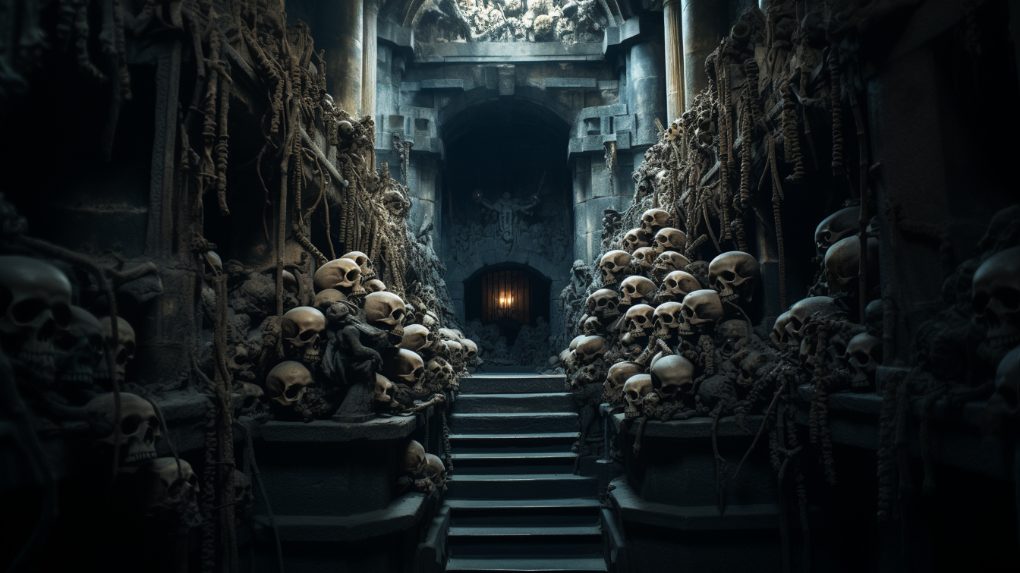Palermo, a city rich with history, has always been a beacon for those seeking the unknown and the mysterious. And in the midst of this vibrant city lies an attraction that beckons visitors from around the world to delve deep into the past and explore the enigma of life and death, housed within the walls of a historic monastery.
Welcome to the catacombs of Palermo, a place where the echoes of history reverberate through the corridors adorned with mummies and relics of a bygone era.
A Peek into the Capuchin Catacombs
The Origins: Capuchin Monastery
In the sixteenth century, the Capuchin monks initiated a unique tradition that would soon evolve into one of Palermo’s most sought after sights. Nestled within the peaceful premises of the Capuchin monastery, the catacombs started as a cemetery for the monks, gradually opening up to include the bodies of local luminaries, priests, and virgins, turning the site into a revered burial ground. Families considered it a status symbol to have their relatives preserved and displayed in this sacred space, offering generous donations to ensure a proper place in this hallowed ground.
A Walk Among Mummified Corpses
As you step inside, the sight that greets you is both eerie and fascinating. Rows of open coffins line the walls, with the bodies dressed in their best attire, signifying the high status these individuals held in life.
Here, men, women, and children lie side by side, with the monks and clerics wearing their clerical vestments, a testament to their dedicated service to the monastery and the community. The mummified corpses, showcasing varying levels of preservation, narrate tales from a time long past, each holding a story etched in the wrinkles of their skin and the fabric of their garments.
The Infamous “Sleeping Beauty”: Rosalia Lombardo
Among the myriad of mummies housed within the catacombs, one figure stands out – Rosalia Lombardo, often referred to as the “Sleeping Beauty”. She died at the tender age of two, but the monks used a special embalming process involving zinc salts and salicylic acid, which not only helped to kill bacteria and fungi but also preserved her body with an almost lifelike quality. Visitors from all walks of life flock to witness the beauty and serenity etched on her face, a poignant reminder of the fleeting nature of life.
Related: The Mystery Behind Mind Reading Tricks – Discover Their Secrets Here
The Process Behind the Mummies
The Importance of Zinc Salts and Salicylic Acid
As one wanders deeper into the catacombs, the secrets behind the remarkably preserved mummies begin to unfold. The monks were adept at using a concoction of zinc salts and salicylic acid in the embalming process, a technique that helped to kill bacteria and fungi, consequently preserving the bodies for centuries. This method was not just a means to stave off decomposition but also a testament to the advanced burial practices of the time.
The Rigours of Body Rigidity
The process of achieving body rigidity in the corpses was a meticulous one. It began with the draining of bodily fluids, followed by a wash in vinegar, a substance that also helped to kill bacteria.
The bodies were then set in their final pose, often emulating a peaceful slumber, before being placed in open coffins or iron grills, allowing for natural desiccation. The catacombs of Palermo offer a vivid glimpse into this fascinating yet macabre world, revealing the lengths to which families went to preserve the memory of their loved ones.
Embalming Process: Preserving for Eternity
Visitors to the catacombs are often struck by the complexity of the embalming process that allowed these bodies to stand the test of time. After the initial preparation, the bodies were treated with various preserving agents, including alcohol, before being dressed in their best attire, a practice that signified their status and wealth.
The catacombs served as a public domain where the bodies, now turned into mummies, were displayed for all to see, a practice steeped in history and tradition.
The Nineteenth-Century Transformation
During the nineteenth century, the catacombs saw a significant transformation. With an increase in generous donations, advancements were made in the embalming process, ensuring a method that effectively killed fungi and bacteria, preserving the bodies with an even greater finesse and artistry.
The catacombs blossomed into a space that represented both the reverence for the dead and the ever-evolving societal norms of the time.
Also read The Ancient Ram Inn A Haunted House with a Dark Past
A Status Symbol: The Local Luminaries and Their Stories
Dressed in Their Best Attire: Clerical Vestments and Beyond
Being buried within the capuchin crypt was not just a matter of death but a status symbol that echoed through the ages. The local luminaries, members of the clergy, and affluent families of Palermo sought their final resting place here, adorning their bodies with clerical vestments and garments that reflected their high social standing. This practice wasn’t confined to adults alone; even children found a place here, their innocence preserved for eternity.
Inside the Open Coffins: A Glimpse into the Past
Step inside this unusual attraction, and one can’t help but feel a sense of connection with the past. The open coffins reveal a glimpse into a bygone era, encapsulating stories of lives lived in full, of love, loss, and devotion. The capuchin catacombs serve as a bridge between the world of the living and the dead, a place where time seems to stand still, offering a unique insight into the complexities of life and death.
The Experience of a Visit
The Iron Grills and Ceramic Pipes: Architectural Highlights
As you navigate through the catacombs, don’t miss the remarkable architectural elements that contribute to this otherworldly experience. The iron grills that segregate different sections give a solemn, respectful separation between the resting places of monks, virgins, and local luminaries.
Meanwhile, the ceramic pipes, a vital component in preserving the bodies, offer a testament to the ingenious engineering that went into making the catacombs a site that could stand the test of time.
The Guy de Maupassant Visit: A Renowned Visitor’s Perspective
To understand the profound impact a visit to the catacombs can have, one only needs to look at the visit by the celebrated writer, Guy de Maupassant. During his visit, the catacombs left an indelible mark on him, influencing his literary works profoundly. His reflections, a melange of awe and philosophical contemplation, offer potential visitors a glimpse into the transformative experience that awaits them.
Planning Your Visit: Tips and Insights
Embarking on a journey to explore the catacombs of Palermo is like stepping back in time, where stories of the dead intertwine with the present. Before you visit, it’s wise to acquaint yourself with the rich history that surrounds this place, allowing for a more profound connection with the stories etched into the very walls of the catacombs.
Dress appropriately to pay respects to the deceased, and perhaps, carry a small token to leave as a mark of your visit, joining a lineage of visitors who have been touched by the timeless beauty and solemnity housed within these ancient walls.
Remember, a visit to the catacombs is not just a tour; it’s an opportunity to reflect on life, death, and the narratives that bind us through the ages. As you walk through the catacombs, allow yourself to be transported to a world where time stands still, offering a unique perspective on life and the ever-present cycle of existence.



